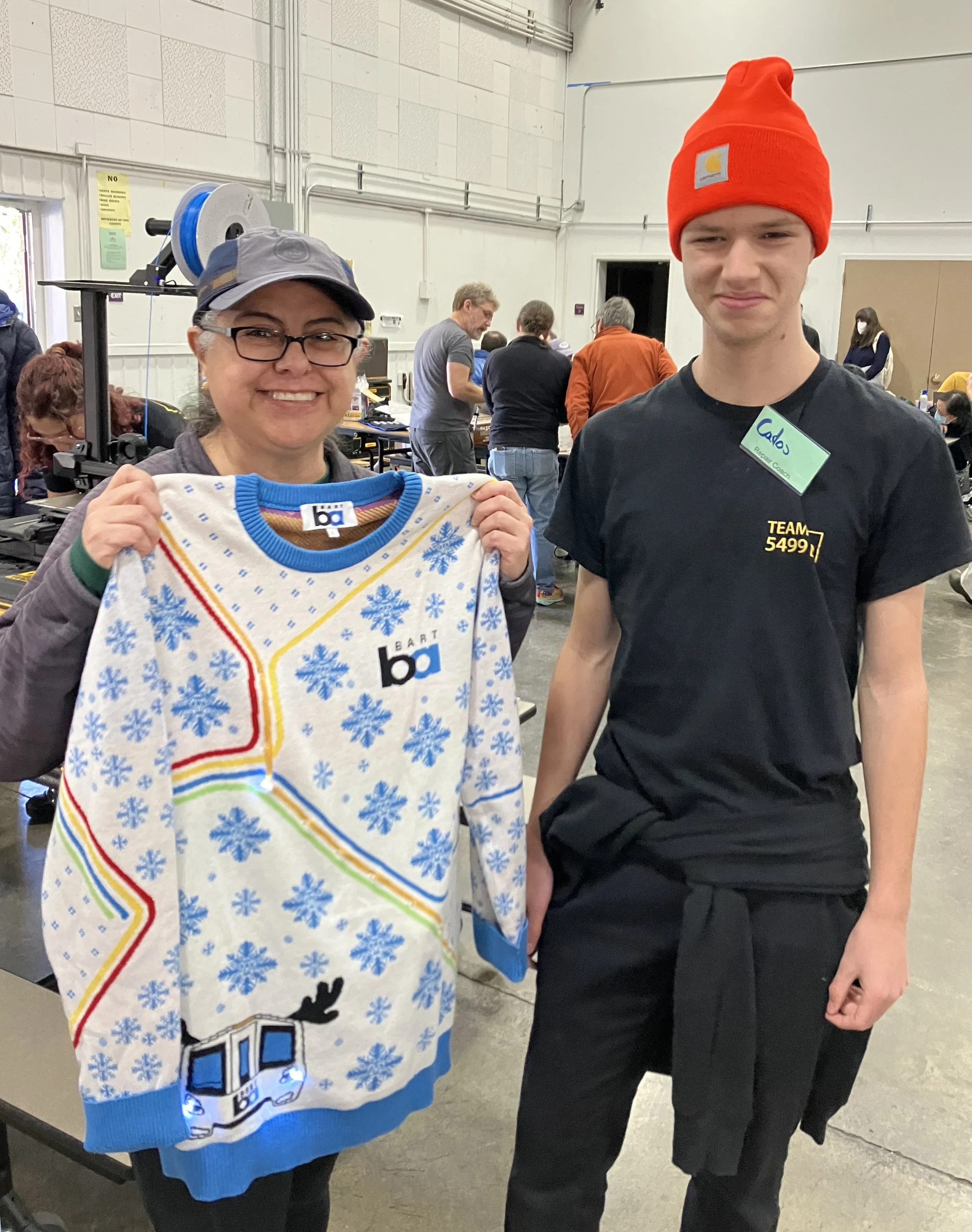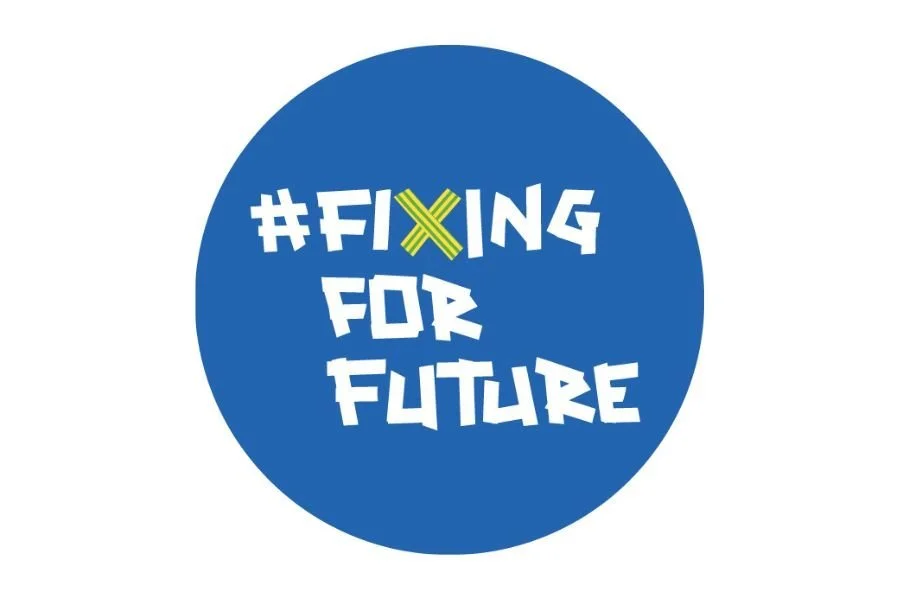A Pathway to Explore
the Transformative Potential of
Repair in STEAM and Maker Programs
Repair offers powerful opportunities for deepening the educational potential of maker programs. It’s well known that maker education goes far in fostering thinking skills and creativity, as well as interest, knowledge and technical skills in STEM subject matter. Incorporating repair into maker programs enriches that learning, while at the same time creating space for cross-disciplinary work and addressing other pressing educational objectives, such as climate literacy and student agency.
The material below develops these ideas and is followed by suggested steps and resources for integrating repair into existing maker programs and tinker spaces.
Whether you're interested in the practical, the technical, the artistic, or any other aspects of repair, you'll find rich inspiration throughout The Culture of Repair Project website.
Be sure to explore our Educator Resource Library, Notes from the Field, and other sections for tools, stories, insights, funding opportunities, and connections to a broader network of educators and advocates teaching youth about repair.
Ways Repair Enriches Maker Programs
Thinking and Technical Skills
Repair calls on the skills and thinking processes central to maker education, yet takes them further. In many circumstances, working within the constraints of the broken object requires deeper understanding and more creative problem-solving than making things from scratch.
Carlos Johns of BUSD Robotics Club and Fix-it Fest participant, after re-soldering her light-up BART sweater.
The limitations of the broken object include:
The materials it’s made of
The condition of the materials
Its parts and how they work together
The object’s function
The availability of replacement parts
The importance of aesthetics, or not, or of authenticity to its original condition.
Additional factors come into play if the broken object belongs to or is important to the student, or if the environmental implications of its going to landfill are understood.
Coming up against limitations – whether they be technical or personal – pushes thinking and skills forward and ties learning into more dimensions of the student’s life experience than do just concepts.
Tip: Partner with an environmental / climate literacy colleague, or a science colleague – ecology, physics or chemistry.
Repair brings caring for the environment squarely into maker programs
Integrating repair into maker programs vastly expands the relevance of those programs to our contemporary world.
Aiming maker skills and thinking at repairing objects means keeping things in service longer, which means reducing carbon emissions and preserving resources. 3-D printing replacement parts to repair a discontinued but otherwise perfectly functional object creates another way of caring for the Earth.
Speaking practically, harnessing maker programs to the momentum behind addressing environmental change contributes to maintaining support for maker education. Cultivating the capacity and inclination of students to repair rather than toss and repurchase links maker education with sustainability.
Tip: Partner with your Climate Literacy Program or other sustainability program, and/or a science or social studies colleague – environmental science, biology, civics.
Repair reveals systems and design
When a student’s object breaks, their personal involvement with it enables them to see design and systems more clearly:
A student acquired an item to serve a purpose.
It fulfilled the need.
It broke – perhaps easily, inexplicably.
It no longer serves its purpose.
Repair-inflected maker skills and inclinations transform a reflexive “toss and repurchase”, into a decision point: “Toss and repurchase, or consider repair?”
Considering repair leads the student to ask:
How is the object designed?
Why did this break?
Why was it designed like this?
Who made it this way?
Could it have been designed differently?
What concerns informed its design?
Whose concerns informed its design?
Are those concerns consistent with my interests?
The student’s personal stake in the item highlights the design concerns informing the item's manufacture. Systems and design are no longer conceptual, classroom topics. The student is personally involved and has a stake in the situation and its resolution.
These questions naturally lead students to explore:
Product design and engineering
Manufacturing decisions and their motivations
Whose needs are prioritized in design — and whose are overlooked?
Many Systems are Explored Through Repair:
Economic systems – linear vs. circular economy, capitalism, consumption
Environmental systems – ecology, resource use, waste
Physiological systems – sensory, cognitive, and motor interactions
Political systems – Right to Repair, regulation, corporate accountability
Social systems – agency, equity, community care
Psychological/economic systems – marketing, branding, desire, identity
Tip: Partner with a social studies colleague.
Repair Deepens Student Engagement
When students are personally invested in fixing their own objects:
Conceptual knowledge becomes experiential
Motivation arises from a personal stake, not external expectations
Learning extends beyond the classroom and into daily life
Tip: Have students bring in their own things to repair.
Support
This is a resource in progress! If you’re integrating repair into your Makerspace Program we would enthusiastically welcome your input. The resources and pathways below are offered to support introducing and integrating repair into your maker programs. Do you have something to contribute to this resource? We invite and welcome your involvement in developing this to be as supportive as possible to Maker-Educators!
Tip: Use this guide to advocate for incorporating repair into your school's maker program.
Share it with colleagues and administrators to build momentum and support.
Ways to Introduce Repair into Maker Programs
Review the sketch above: “Ways Repair Enriches Maker Programs”
Use iFixit’s “Explore Repair” to Orient
Use iFixit’s Explore Repair to orient yourself with issues and opportunities relative to repair. Consider using it with your students as well.
Review “Cultivating a Repair Mindset Toolkit”
A group of maker-educators researched how repair enriches maker pedagogy and curriculum. They designed, tested and published their findings alongside teaching tools grounded in that research. Read the introduction. Learn more about and download the Toolkit.
Review “Fixing Things for the Future: A Practical Guide to Setting Up a Student-Run Repair Shop”
While this program by the Steiner School may be more comprehensive than you’ll implement right out of the gate, it’ll expand how you’re thinking about repair and will inform the shape and scope of the repair program you’re considering. Read the introduction. Learn more about and download Fixing Things for the Future.
Review the Library
There are many resources in the Educator Resource Library well-suited for bringing into or adapting for makerspaces.
Filter on “Hands-on in Program” to find programs grounded in hands-on learning (such as Riot Refurb and Repair What You Wear).
Filter on “Interactive - Activity” to find discrete hands-on activities (such as Teaching Lamp Repair and Stitching Stuffies).
Review Notes from the Field
Check out essays by people teaching repair for information, guidance and inspiration. This new resource was launched with essays out of two collaborations between maker and climate literacy programs. Check out Ellen McClure’s and Gloria Harwood’s essays.
Review “Restart at School”
A manageable first step might be to bring the “Restart at School” into your maker program as an after-school project. The program concludes with students hosting their own community repair event at school.
Collaborate with a Local Repair Group
If there is a community repair initiative nearby (e.g., Fixit Clinic, Repair Café, Restart Party), they will be an excellent resource for finding community volunteers to help with technical and organizational matters for either an after-school or in-class program.
Go to Community Repair Events and Schools for suggestions and resources. Community repair events are hosted by many public libraries in the US. (See these articles: Programming Librarian and American Libraries.)
Host a Community Repair Event
Community Repair Events are extremely popular. Host an event at your school to garner community support for your work, to serve the community, to create a forum for talking about the environment, and to let students lead and model what is possible with repair. Go to this page about Community Repair Events and Schools for information about how to find and collaborate with existing groups in your community, as well as how to set one up at your school.
Learning as you go
After holding a more limited after-school project you will know much more about how repair can enrich your maker program, equipping you to continue forward in the way that makes most sense for your particular circumstance - working with your resources, constraints, opportunities and priorities toward your objectives that shape what you do.
Network with other Repair Educators and Advocates
Be in touch, and reach out if we can connect you with anyone in a similar role or locale! We celebrate and support your visions for teaching repair :)
















